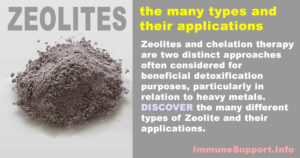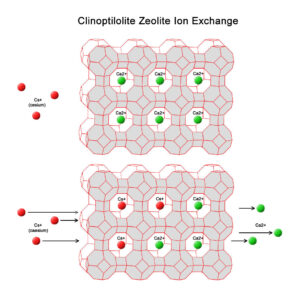Zeolite, the Many Types and Their Applications
Zeolite Benefits:
Absorption Properties: Zeolites have a porous structure that allows them to adsorb and trap certain ions and molecules. This property is utilized in various industrial applications, such as water purification and gas separation[i].
 Agricultural Use: Zeolites are some times used in agriculture to enhance soil quality. They can improve water retention, nutrient availability, and overall soil structure, including regulating pH level, promoting plant growth[ii].
Agricultural Use: Zeolites are some times used in agriculture to enhance soil quality. They can improve water retention, nutrient availability, and overall soil structure, including regulating pH level, promoting plant growth[ii].
Dietary Supplements: Some zeolite products are marketed as dietary supplements for human consumption. Studies support the ability that zeolites can bind to heavy metals and toxins in the digestive tract, and assist in their elimination from the body[iii]–[iv].
Potential Detoxification Aid: The ability of zeolites to bind to certain substances has led to their application to be used as detoxification agents-[v][vi]. However, the scientific evidence supporting their efficacy in this regard is limited and controversial.
Zeolites are a group of crystalline, hydrated aluminosilicate minerals with a three-dimensional framework structure. There are various types of zeolites, each with its unique properties and applications. Here are some common types of zeolites:
 Clinoptilolite:
Clinoptilolite:
- Clinoptilolite is one of the most commonly found natural zeolites. This type appears to be the most popular for dietary supplement applications, including brain health[vii]–[viii]. It also has undergone long term use studies[ix]. In one recent clinincal study, this substance combined with another substance was shown to reduce the amount of “Forever Chemicals” and Graphene Oxide from the human body.
 It is highly inert and safe for human utilization[x].One of the main reasons clinoptilolite zeolite is used in dietary supplements is its ability to act as a detoxifying agent. Zeolites have a porous structure with a negatively charged surface, allowing them to attract and trap positively charged ions or molecules, such as heavy metals and toxins. This property makes clinoptilolite zeolite a potential candidate for supporting detoxification processes in the body. It has a high affinity for heavy metals like lead, cadmium, and mercury. When consumed, it binds to these, preventing their absorption into the bloodstream. They then are then excreted from the body. It is known for its high cation exchange capacity and has proven useful in the elimination of a variety of contaminants from the body or in amelioration of the intestinal status[xi].
It is highly inert and safe for human utilization[x].One of the main reasons clinoptilolite zeolite is used in dietary supplements is its ability to act as a detoxifying agent. Zeolites have a porous structure with a negatively charged surface, allowing them to attract and trap positively charged ions or molecules, such as heavy metals and toxins. This property makes clinoptilolite zeolite a potential candidate for supporting detoxification processes in the body. It has a high affinity for heavy metals like lead, cadmium, and mercury. When consumed, it binds to these, preventing their absorption into the bloodstream. They then are then excreted from the body. It is known for its high cation exchange capacity and has proven useful in the elimination of a variety of contaminants from the body or in amelioration of the intestinal status[xi].
- Clinoptilolite is one of the most commonly found natural zeolites. This type appears to be the most popular for dietary supplement applications, including brain health[vii]–[viii]. It also has undergone long term use studies[ix]. In one recent clinincal study, this substance combined with another substance was shown to reduce the amount of “Forever Chemicals” and Graphene Oxide from the human body.
- Mordenite:
- Mordenite is a zeolite that has a fibrous or acicular crystal habit. It is not considered safe for human consumption[xii]. It is used in catalysis and as an adsorbent for certain molecules.
- ZSM-5:
- ZSM-5 is a synthetic zeolite with a high silica-to-alumina ratio. It is widely used in the petrochemical industry as a catalyst for various processes, including the conversion of alcohols to gasoline[xiii].
- Y-Type Zeolites:
- Y-type zeolites, such as faujasite (X and Y), are often used as catalysts in the petroleum and chemical industries. They have large cavities and are suitable for catalyzing reactions involving large molecules[xiv].
- A-Type Zeolites:
- A-type zeolites, like chabazite and analcime, have smaller cavities compared to Y-type zeolites. They are used in applications such as gas separation and water softening[xv].
- Linde Type A (LTA):
- Linde Type A zeolites have a high silica-to-alumina ratio and are used in adsorption and separation processes. They are also utilized in molecular sieve applications[xvi].
- Faujasite:
- Faujasite is a type of Y-type zeolite and is widely used as a catalyst in the petrochemical industry. It has large cavities, making it suitable for catalyzing reactions involving large molecules[xvii].
- Chabazite:
- Chabazite is an A-type zeolite and is used in various applications, including catalysis and gas separation. It is known for its relatively small pore size. This zeolite, along with phillipsite and analcime zeolites, provided protection against oxidative stress by increasing the levels of important antioxidant enzymes and reducing oxidative stress. Further, this combination has a high cation-exchange capacity of 400 meq/100 g, which is greater than that of other zeolites, and appears to have the ability to remove not only toxins and biological waste but also absorb other molecules[xviii].
- Erionite:
- Erionite is a fibrous zeolite and is considered a potential health hazard due to its association with respiratory diseases. It is found in certain geological formations[xix].
- Heulandite:
These are just a few examples of the many types of zeolites, and each type has specific characteristics that make it suitable for particular applications. The diverse properties of zeolites also make them valuable in industries such as catalysis, adsorption, and ion exchange.
- Regulation and Safety:
- Clinoptilolite Zeolite supplements are found in the chelation therapy field and is generally considered safe.
- Individual Responses:
- Responses to both zeolite supplements and chelation therapy can vary among individuals. Conduct through research and/or you may wish to consult with a healthcare professional.
In conclusion, natural Clinoptilolite zeolite and chelation therapy is a popular method for heavy metal and other toxic removal. Always consult with a heath care professional before taking any product.
NEXT: Clinoptilolite Zeolite. The Ultimate Safe and Effective Detoxifier of Deadly Toxins
<<<BACK NEXT>>>
Citations
[i] Pérez-Botella E, Valencia S, Rey F. Zeolites in Adsorption Processes: State of the Art and Future Prospects. Chem Rev. 2022 Dec 28;122(24):17647-17695. doi: 10.1021/acs.chemrev.2c00140. Epub 2022 Oct 19. PMID: 36260918; PMCID: PMC9801387.
[ii] Szatanik-Kloc A, Szerement J, Adamczuk A, Józefaciuk G. Effect of Low Zeolite Doses on Plants and Soil Physicochemical Properties. Materials (Basel). 2021 May 17;14(10):2617. doi: 10.3390/ma14102617. PMID: 34067914; PMCID: PMC8156034.
[iii] Mastinu A, Kumar A, Maccarinelli G, Bonini SA, Premoli M, Aria F, Gianoncelli A, Memo M. Zeolite Clinoptilolite: Therapeutic Virtues of an Ancient Mineral. Molecules. 2019 Apr 17;24(8):1517. doi: 10.3390/molecules24081517. PMID: 30999685; PMCID: PMC6515299.
[iv] Senila M, Cadar O. Modification of natural zeolites and their applications for heavy metal removal from polluted environments: Challenges, recent advances, and perspectives. Heliyon. 2024 Feb 4;10(3):e25303. doi: 10.1016/j.heliyon.2024.e25303. PMID: 38352776; PMCID: PMC10862511.
[v] Kraljević Pavelić S, Simović Medica J, Gumbarević D, Filošević A, Pržulj N, Pavelić K. Critical Review on Zeolite Clinoptilolite Safety and Medical Applications in vivo. Front Pharmacol. 2018 Nov 27;9:1350. doi: 10.3389/fphar.2018.01350. PMID: 30538633; PMCID: PMC6277462.
[vi] Kraljević Pavelić S, Saftić Martinović L, Simović Medica J, Žuvić M, Perdija Ž, Krpan D, Eisenwagen S, Orct T, Pavelić K. Clinical Evaluation of a Defined Zeolite-Clinoptilolite Supplementation Effect on the Selected Blood Parameters of Patients. Front Med (Lausanne). 2022 May 27;9:851782. doi: 10.3389/fmed.2022.851782. PMID: 35712111; PMCID: PMC9197155.
[vii] Mastinu A, Kumar A, Maccarinelli G, Bonini SA, Premoli M, Aria F, Gianoncelli A, Memo M. Zeolite Clinoptilolite: Therapeutic Virtues of an Ancient Mineral. Molecules. 2019 Apr 17;24(8):1517. doi: 10.3390/molecules24081517. PMID: 30999685; PMCID: PMC6515299.
[viii] Mery Montinaro, Daniela Uberti, Giuseppina Maccarinelli, Sara Anna Bonini, Giulia Ferrari-Toninelli, Maurizio Memo, Dietary zeolite supplementation reduces oxidative damage and plaque generation in the brain of an Alzheimer’s disease mouse model, Life Sciences, Volume 92, Issues 17–19,2013, Pages 903-910, ISSN 0024-3205.
[ix] Dolanc I, Ferhatović Hamzić L, Orct T, Micek V, Šunić I, Jonjić A, Jurasović J, Missoni S, Čoklo M, Pavelić SK. The Impact of Long-Term Clinoptilolite Administration on the Concentration Profile of Metals in Rodent Organisms. Biology (Basel). 2023 Jan 26;12(2):193. doi: 10.3390/biology12020193. PMID: 36829471; PMCID: PMC9952783.
[x] Pavelic K., Hadzija M. Handbook of Zeolite Science and Technology. Dekker; New York, NY, USA: 2003. Medical applications of zeolites; pp. 1143–1174
[xi] Kraljević Pavelić S, Simović Medica J, Gumbarević D, Filošević A, Pržulj N, Pavelić K. Critical Review on Zeolite Clinoptilolite Safety and Medical Applications in vivo. Front Pharmacol. 2018 Nov 27;9:1350. doi: 10.3389/fphar.2018.01350. PMID: 30538633; PMCID: PMC6277462.
[xii] Giordani M, Ballirano P, Pacella A, Meli MA, Roselli C, Di Lorenzo F, Fagiolino I, Mattioli M. Another Potentially Hazardous Zeolite from Northern Italy: Fibrous Mordenite. Minerals. 2022; 12(5):627. https://doi.org/10.3390/min12050627
[xiii] https://www.sciencedirect.com/topics/chemical-engineering/zsm-5-zeolite
[xiv] https://www.acsmaterial.com/blog-detail/y-type-zeolites.html
[xv] https://www.acsmaterial.com/blog-detail/type-a-and-x-zeolites.html
[xvi] https://iopscience.iop.org/article/10.1088/1742-6596/1376/1/012041
[xvii] https://www.clariant.com/en/Solutions/Products/2019/04/24/08/20/Faujasite-Zeolites-FAU
[xviii] Dogliotti G, Malavazos AE, Giacometti S, Solimene U, Fanelli M, Corsi MM, Dozio E. Natural zeolites chabazite/phillipsite/analcime increase blood levels of antioxidant enzymes. J Clin Biochem Nutr. 2012 May;50(3):195-8. doi: 10.3164/jcbn.11-63. Epub 2011 Nov 29. PMID: 22573920; PMCID: PMC3334371.
[xix] Giordani M, Ballirano P, Pacella A, Meli MA, Roselli C, Di Lorenzo F, Fagiolino I, Mattioli M. Another Potentially Hazardous Zeolite from Northern Italy: Fibrous Mordenite. Minerals. 2022; 12(5):627.
[xx] https://www.britannica.com/science/heulandite
[xxi] https://www.sciencedirect.com/topics/chemistry/heulandite

